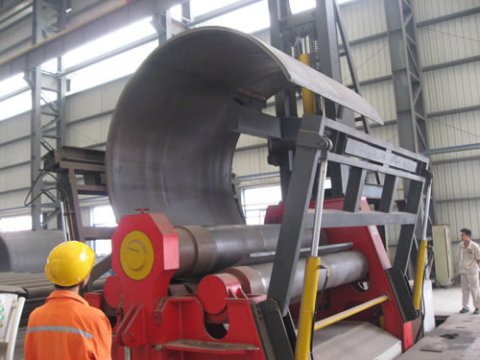Plate bending machines
Hydraulic Four Roller Plate Roll bender
Two Roller Steel Bending Machine
Three Roller Bending Machine
Four Roller Rolling Machine
Profile bending machine
Auxiliary products
Upper Roll Bending Machines
Industry News
Hydraulic symmetrical rolling machine with 3 rollers : Structure Principle &echnical Advantages
The Hydraulic symmetrical rolling machine with 3 rollers is a high-precision metal forming device based on hydraulic servo control. By coordinating the movement of three rollers, it produces continuous plastic deformation of metal plates. This machine is primarily used to manufacture cylindrical, conical, and transition-surface shells, such as pressure vessel shells, oil storage tanks, and pipeline elbows.
Hydraulic symmetrical rolling machine with 3 rollers : Structure Principle
Structure
Upper Roller Assembly: Forged from high-strength alloy steel, the prestressed drum-shaped roller body undergoes surface hardening treatment (HRC55–60). A double-acting hydraulic cylinder provides accurate vertical positioning with a ±50 mm stroke and ±0.1 mm repeat positioning accuracy. The specially designed roller crown compensation mechanism dynamically adjusts crown curvature (0–3°), effectively eliminating the “straight edge effect.”
Lower Roller Drive System: Two parallel lower rollers are powered by a planetary reducer + synchronous gearbox (infinitely adjustable speed ratio 1:10–1:100), delivering torque of 80–200 kN·m. Alternatively, a direct hydraulic motor drive can be configured. Roller shafts are supported by double-row spherical roller bearings, ensuring coaxiality ≤0.03 mm/m under heavy load.
Hydraulic Control System
The integrated proportional valve group + digital servo pump station forms a closed-loop control system, offering pressure adjustment from 5–32 MPa and flow accuracy within ±1%. The upper roller achieves stepless lifting speeds of 0.1–20 mm/s, with fast/slow switching in under 0.5 s.
The system includes an intelligent pressure compensation module, which automatically adjusts pressing force based on plate yield strength (σs = 245–1100 MPa). It supports a multi-material process database covering carbon steel, stainless steel, and aluminum alloys.
Auxiliary Function Modules
Optional CNC support roller device (±0.05 mm accuracy), with a hydraulic pushing mechanism to shorten the effective rolling span, controlling diameter tolerance within D ± 0.3%.
Integrated laser alignment sensor and online plate thickness detector monitor plate deviation (0.02 mm resolution) and feed thickness variation in real time.
Plate Forming Process: Four Deformation Stages
- Pre-Bending Stage: The upper roller quickly descends to the initial contact point. A hydraulic accumulator provides instantaneous impact force to complete end pre-bending (R ≥ 200 mm).
- Main Rolling Stage: The lower rollers drive at a preset linear speed (0.5–3 m/min). Meanwhile, the upper roller applies 20–150 tons of pressure. Through multi-pass progressive bending (≤8% deformation per pass), uniform plastic deformation is achieved.
- Rounding Stage: The geometric properties of the crowned roller enable automatic springback compensation. Fine-tuning of the upper roller eliminates elastic recovery (springback angle compensation accuracy ±0.5°).
- Unloading Stage: The hydraulic cylinder quickly lifts the upper roller (50 mm/s). A mechanical limit device ensures safe operation during unloading.
Hydraulic symmetrical rolling machine with 3 rollers : Technical Advantages
Precision Manufacturing
- Optimized roller gap parameters using a three-point bending mathematical model, limiting diameter deviation to ±0.15%D (D = shell diameter).
- The hydraulic system employs load-sensitive control technology, keeping pressure fluctuations ≤±2 bar, ensuring thin-plate rolling (δ ≥ 3 mm) without deformation.
Intelligent Features
- Equipped with PLC + industrial touchscreen HMI, storing more than 100 sets of process parameters.
- Optional MES system interface enables process traceability, including pressure-displacement curves and temperature records.
Extended Applications
- By replacing roller assemblies, the machine can also process curved plates and fan-shaped plates.
- Modular design supports dual-machine linkage, handling plate widths up to 4000 mm.
Maintenance Guidelines
- Regularly check hydraulic oil cleanliness (NAS level 8 recommended) and replace filters every 2000 hours.
- Calibrate roller surface parallelism monthly using a laser distance meter (tolerance ≤0.05 mm/m).
- During long-term shutdown, protect the worm gear reducer from rust and maintain the hydraulic system at 0.1–0.2 MPa holding pressure.
Conclusion
The Hydraulic symmetrical rolling machine with 3 rollers combines high-tonnage rolling capacity with micron-level geometric accuracy control. It is widely used in chemical equipment, petroleum storage and transportation, food processing, and nuclear power pipeline manufacturing.








